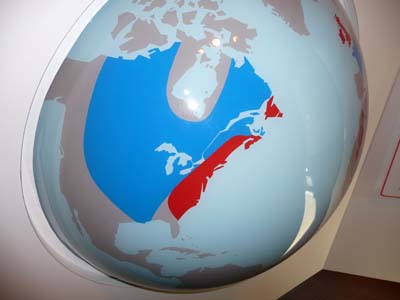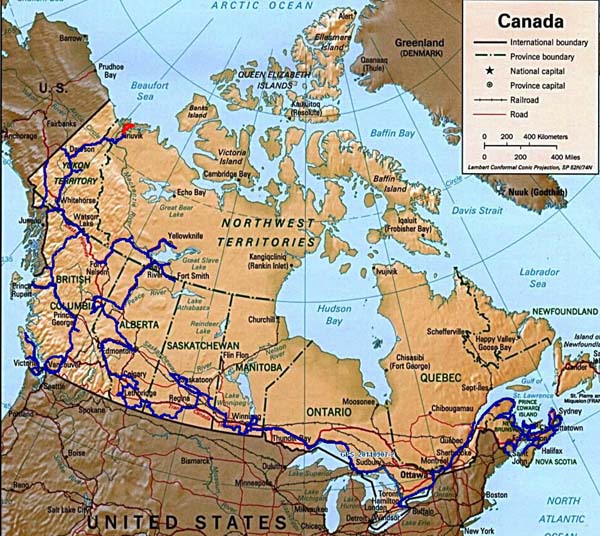Final report of the trip in Canada
I History:
---- Seventy million years ago the time of dinosaurs populated the south of
Alberta of saurian found fossilized.
---- 25000 BC the first human cross the terrestrial bridge between Siberia and
North America by following the “Moose” to spread up to South America.
---- 4500 BC the ancestors of Inuit's cross the Bering Strait too.
---- Before the arrival of Europeans First Nations are divided into five
groups from Pacific to the Arctic.
---- 1000 AD the Viking Leif Ericksson approached Anse-à-Meadows in the north
of Newfoundland.
---- 1497 John Cabot arrived at Cape Breton followed by fishermen
attracted by the abundance of cods.
---- François 1st dispatched Jacques Cartier to discover new wealth without
finding the least metal nugget. He accomplished three voyages in 1534-1535.
---- In 1588 France took the control of fur trade. It was the beginning of the
opposition between France and England for the control of North America for
skins of hat.
---- 1604 Foundation of Sainte. Croix then of Port-Royal, birth of Acadia.
---- 1608 Foundation of the town of Quebec then of Nouvelle-France in the name
of King of France by Samuel de Champlain.
---- 1670 French Radisson and Des Grossiers affirms that the areas most favourable
for furs were in the west of the Lake Superior with easy access from Hudson Bay.
But Charles II of England hastened to create the Company of Hudson Bay, HBC, for
ensures his sovereignty on Rupert's Land, 40% of current Canada. These two nations
claim to dominate the area.
---- 1713 the Treaty of Utrecht put at end the war of 1701-1713 recognizing
the sovereignty of England on Hudson Bay and Newfoundland.
---- 1754 the seven year war between France and England ended in the catch of
Louisbourg and Cape Breton giving to England the control of the entry of
Saint-Laurent Gulf.
---- 1759 the British attacked by surprised the town of Quebec and demolished
the French in one hour of a bloody battle with the death of the two Generals.
---- 1760 the battle of Ristigouche announced the end of the domination of
France signed with the treaty of Paris on February 10, 1763.
Three headaches fell down on the English authorities:
1--- the attack of the First Nations involved Royal the Proclamation 1763
which forbade the colonists to settle in the west of the Appalachian
Mountains, remained without effect,
2--- the restrictions of the rights of French to oblige them to leave,
remained without effect,
3--- the beginning of the revolution in the American colonies involving their
independence on July 4, 1776,
The governor of the provinces of Canada made an alliance of reason with French
of Quebec to prevent that they support American, effective. The arrival of the
Loyalists from the USA populated the colonies of Canada to the detriment of
French previously majority.

Nouvelle-France in blue before the Treaty of Paris in 1763 and the English possessions in red before the independence of the USA in 1776.
---- 1791 the territory of Canada was divided into two parts, Upper Canada (Ontario) and Lower Canada (Quebec) respectively under the authority of a British governor.
---- 1775 & 1812 the USA will in vain make two attempts for annexation of Canada.
---- 1837 the rebellion of the leaders of the two parts of Canada, William J.
McKenzie and Louis-Joseph Pappineau quickly controlled.
---- 1840 the Act Union under the authority of John Lambton concretizes his
vision: “French culture and society were inferior”; The fusion of the two
parts Upper & Lower Canada in only one Parliament exacerbated the nationalism
of majority French in Quebec.
--- 1864 the birth of modern Canada at Charlottetown, Prince-Edward-Island,
who took effect in July 1, 1867 under the name of Dominion of Canada.
It was the beginning of the territorial extension towards the west after the
USA bought Alaska to Russia in 1867. A note of the American Secretary of State
recommended an annexation of the west territories:
1--- Purchase by England of Rupert's Land to HBC to found Northwest
Territories (NWT). The problems arising from the Métis and their leader Louis
Riel in Red River and Fort Garry (Winnipeg) because of the rights of ownership
ended tragically by the execution of an English prisoner by Riel. England
extracted Manitoba from the NWT and its fastening with the Dominion.
2--- 1866 the creation of British Columbia by the union of New Caledonia and
Vancouver Island. The economic advancement of the new province came from
discovered of gold involving a Gold Rush which was completed quickly plunging
the BC in the poverty which was attached to the Dominion in 1871 by assuming
its debts.
3--- 1885 the completion by McDonald governor of the construction of Canadian
Pacific Railway was essential for the unification of the Dominion and the
beginning of the economic advancement of the country.
1884 the continuation and end of the problems with Métis, which exiled themselves in Saskatchewan at Batoche. The L. Riel's return, he created a provisional government, but times had changed. The railroad made it possible the British authorities to bring in a few days of troops involving the rendering of Batoche and the hanging of L. Riel the following year. He was rehabilitated in 1998 and his statue is before the Parliament in Ottawa.
II Facts:
At the beginning of the 20th century the economic advancement was thanks to
gold mines, cereal farming, forestry and oil industries. By the two World Wars
involved an awakening of Canadian reticent to send their children to be killed
in Europe at the request of the colonial British authorities:
---- 1931 the “Statue of Westminster” of the English Parliament remained in
the paperboards,
---- April 17, 1982 Canada Act signed by Elisabeth II in Ottawa created a
constitutional monarchy with two rooms and a British governor to inaugurate
“the chrysanthemums”.
At the beginning of the 21st century the economic development packed with the discovery of new natural resources, oil, gas and especially diamond mines propelling Canada at the third rank of the world producers.

Tracklog of the trip
I Team:
Always the same one with indefectible MAN truck and its driver, Guy…
II Journey:
The journey initially envisaged was followed overall with specific
alternatives.
2.1 The circuit: The
plan of road
is given for Canada and the USA. I drove +30,000 kilometres that is to say on
average 200 kilometres a day.
2.2 The road network: The road network is very vast composed of
Hwys of very variable quality, from excellent to very bad, and gravel roads
often of better quality than some Hwys. Vertical and horizontal signs are of
very good quality, in some provinces in English and French. The road patrol,
Mounties, is not very present.
2.3 Drivers Canadian: The speed limits are 50km downtown and
from 100 to 110km on the roads in open country. Downtown drivers are very
careful on the other hand in the countryside they drive at the limited speed.
Of course there is no road trains as in Australia but only long vehicles
circulating at the limited speed.
2.4 The insurance of the vehicle: I had an insurance obtained by
a German agency, Nowag Internationale
Versicherungen, at Chartis for Canada and the USA.
III Bivouacs:
Booklets of Visitor Information Centers, VIC, give the addresses of
campgrounds with GPS co-ordinates and the dates of openings and closings,
between end-August and mid-October. Out tourist season it is easy to bivouac
on the carparks of closed attractions! In spite of prohibitions of some
Walmart carparks I bivouacked there. Contrary to California the wild
campground is tolerated by the neighbouring population, I was never dislodged
by “Mounties”. All the places of bivouac are given with GPS co-ordinates, cf.
campsite position.
IV Supply of food:
The supermarkets, Walmart and consorts, are present in all the country. They
are parking for overnight. All McDo have free WiFi access with a connection
from carpark. Some Visitor Centers offers a WiFi connection sometimes not
free.
V Fluids:
Petrol stations distributing diesel, are primarily present outside of cities.
It is necessary to be vigilant and envisage to fill the tank in good time. Oil
changes of my truck were carried out by the Volvo workshops. For water I
filled the tanks at the time of a stay on a campground to use the Laundromat
in particular.
VI Money:
HSBC Bank is present in all capitals and large industrial towns.
VII Guide books:
As before I used Lonely Planet, Lp, with a critical eye. Tourist booklets are
very abundant and well documented. The VIC generally practice English and
French.
VIII Passport, visa, border crossing:
The entry Canada is a matter of form, almost without control of my vehicle.
The visa on arrival, VOA, is six months. The Carnet de Passage en Douane, CPD,
was required on the departure from Brisbane and the arrival in Vancouver. But
it seems that it is not requested at land borders.
IX My appreciation:
9.1 I liked:
-- Landscapes are stunning. In the great northern areas settlements are seldom
whereas in the south population is always omnipresent.
-- I discovered civilizations of the First Nations, Métis and Acadians, but
too superficially awaited the closing of museums and attractions out the
tourist period, July-August.
-- British colonial architecture is less ostentatious than in Australia, the
Golden Rush poured less money.
-- Museums in large cities gather objects of First Nations and settlers. Art
galleries are centered on Canadian artists
-- The motivation of first settlers was quite different from that of the ones
in Australia inducing a specific social behaviour.
9.2 I hated:
-- The state of the roads is too often degraded by the succession of rigorous
winters, but modern techniques can do roads out icy. The major problem is the
financing of the road maintenance in this vast country.
9.3 I regretted:
-- Tourist season is very short, July & August. It is impossible to visit it
uninterrupted, it would be necessary to make several two-month trips!
X Relevance of the trip by camper:
The visit of Canada with a motor home does not pose obviously any problem.
American northern culture is made of nomadism to find work and for the third
age fleeing the great agglomerations and the long winter months by heading to
the USA, “snow bird”.